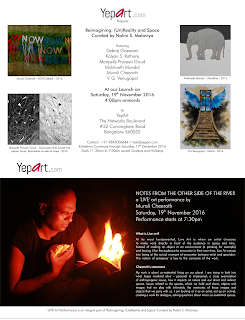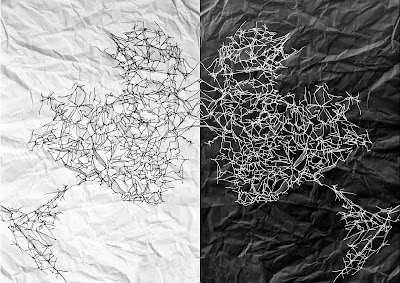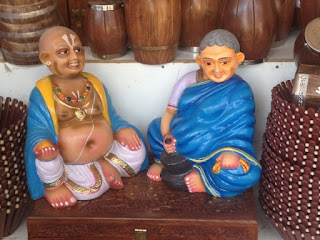Reimagining: (Un)Reality and Space curated by Nalini S Malaviya marks the official launch of Yepart.com. The exhibition features recent works by Debraj Goswami, Kalyan S Rathore, Maripelly Praveen Goud, Muktinath Mondal, Murali Cheeroth and Venugopal VG
Muktinath Mondal focuses on ecological imbalance, a disrupted equilibrium - a direct result of human interventions. He paints a stark image - black canvases that point to a dark reality, a glimpse into a bleak future that interrogates the very existence and survival of living beings. An increasingly fragile eco-system disintegrates and vanishes as a materialistic world prevails. Time as a distant phenomenon assumes vital relevance, and its catastrophic fate becomes inevitable, unless the current variables are harmonised. The red highlights in the paintings form the primordial link, the essential connective tissue between the various species including mankind, and which innately determines their coexistence.
The show opens on 19 Nov 2016 at Hatworks Boulevard, Cunningham Road, Bengaluru and continues till 17 Dec 2016.
Reimagining: (Un)Reality and Space
Observation, truth and materiality interweave to create alternative realities that occupy a realm which is corporeal, yet fictitious, clouding lines of physicality of dimensions. The plurality inherent in existing and functioning within these coordinates, challenge and inspire individuals to examine the intrinsic harmony and conflict embedded in such systems, and simultaneously imagine new spaces. Notions of time and space amidst variables construct fresh associations and connotations, where the resulting topography is a visually enriching landscape capturing points of dissonance and accord, shifts in reality, and reimagined spaces.
The artists' critical engagement with the curatorial premise reimagining (un)reality and space, results in interventions, which explore and question notions of time, space, reality and the subjective relativity that pervades through these dimensions. Multiple realities emerge from stresses of urban living, where observation and truth is skewed and dependent on other dynamics. Ideologies contort for material gains and govern the present and the future. Cognitive and sensory perceptions distort from an altered state of consciousness. The time and space thus occupied is unreal and fabricated as a spontaneous outcome, which is ungoverned by design.
There is an attempt to delve into conflicts, and examine the inherent precariousness and fragility entrenched in natural systems, which are impacted by consumerism and materialistic trends. Reimagining spaces create virtual maps of imaginary loci, introspective journeys in search of the self and enquiries on the 'now' form intriguing visual chronicles of contemporary concerns.
Debraj Goswami contemplates an alternative state of reality that exists in parallel, blurring the boundaries of factual and unreal, and creating distorted dreamlike states. Subconscious preoccupations dictate existence, to assume a truth that is probably fictional and appears surreal. The complexities of living ensure that perceptions of real, unreal and simulated become indistinct and a machine made robotic existence dominates. Past, present and future concerns manipulate sensory reality to form a convoluted sense of the real, and living in the moment becomes a figment of imagination in unusual and often humorous ways.
Kalyan S Rathore’s sculptures exist in a metaphysical context, where time and space are no longer linear entities but transcend corporeal boundaries. The repetition of the sculptural unit akin to fractals in the universe, construct forms that are non-representational and non-specific to natural features. Conceptually based, they explore a fluid reality, while attempting to negotiate a labyrinth that forms life’s journey. The quest for the spiritual and transcendental leads to an introspective process that pauses for self-reflection, while encountering chaos and conflict during the course.
Maripelly Praveen Goud extends the materiality of the print medium to create virtual contours and linear graphs that map imaginary loci and places. Relying on scrunching the paper as a means to initiate cathartic release, the process spontaneously creates dimensions beyond the surface of the plane. The accidental lines morph into unspecified shapes, forms and maps allowing multiple readings - the markings could be representations of metaphorical sites or subconscious points of reference. The material and the medium combine to form layers of meanings within the conceptual maps.
Muktinath Mondal focuses on ecological imbalance, a disrupted equilibrium - a direct result of human interventions. He paints a stark image - black canvases that point to a dark reality, a glimpse into a bleak future that interrogates the very existence and survival of living beings. An increasingly fragile eco-system disintegrates and vanishes as a materialistic world prevails. Time as a distant phenomenon assumes vital relevance, and its catastrophic fate becomes inevitable, unless the current variables are harmonised. The red highlights in the paintings form the primordial link, the essential connective tissue between the various species including mankind, and which innately determines their coexistence.
Murali Cheeroth examines the notion of time as a relative value, with its meaning and intent evolving and transfiguring as a quotient of consciousness, application and relevance. Engaging with the interplay of text, material, texture and aesthetics, the concept of time morphs into multiple meanings and discourses, which reflect the subjectivity of viewing and reading into the artwork. Expressing time as a function of cognitive, linguistic and visual interactions, its reading draws from multiple standpoints, ranging from the personal to the historical. His performative artwork relates to issues linked to microcosmic spaces, which are intimate, act as receptacles of memories and share an indispensable interrelationship with the larger environment.
Venugopal VG explores the dichotomy inherent in situations emerging from urban living, and portrays complexities and dilemmas of reality. Pictorial elements indicating human emotions, desires and relationships construct paradoxes that emphasize the fragility of urban reality. Manipulating and combining physical, emotional and spatial derivatives, the narratives that are created are constructed to create a transmuted reality that is derived from factual components. Identity, migration, adaptability, and transformation are some of the critical issues that explore existential crisis to form imagery which warp representations of reality.
The exhibition will be available online on www.yepart.com from 19th November 2016.
Do visit the exhibition and share your thoughts in the comments section below or write on nalini.indianart@gmail.com.
If you would like to interview the artists, review or cover the event on your blog/website, or for any other media enquiries, please get in touch on nalini.indianart@gmail.com/ naozar@yepart.com/ +91 98450 06644
If you enjoyed reading this article, do share it using the social media widgets at the top and subscribe to receive regular updates from Art Scene India
Related posts,
- Art Investment: The Fine Art of Collecting
- Art Advice: Market Mantra, Education Times, Bangalore
- TIPS: 10 Tips For Buying Art
- TIPS: 5 Reasons a Good Catalogue Text is Essential for Your Art
- TIPS: 6 Tips On How To Approach An Art Gallery And Find Gallery Representation
- TIPS: Exhibiting Art in Non-Gallery Spaces
- TIPS: Guide To Exhibiting Your Artworks
- TIPS: How To Write An Artist Statement
- TIPS: How to Create an Online Presence
- TIPS: How to organize an art exhibition















